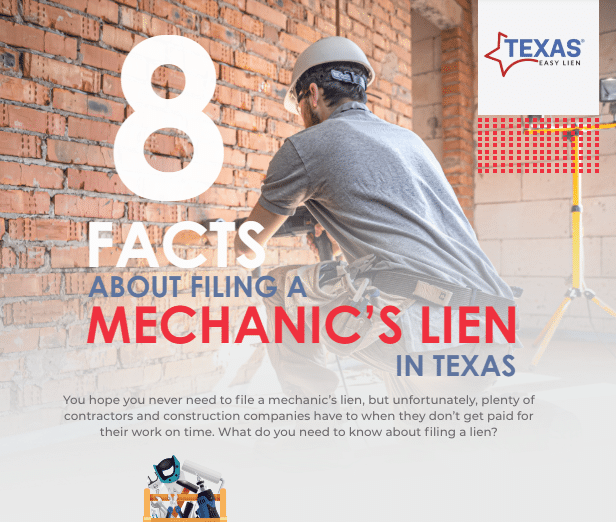Running a small construction or contractor business is hard work, and it’s even harder the smaller your business is. Of the 680,000 construction companies in the United States, most are small operations with 20 employees or fewer. This small size often means razor-thin margins, and every check coming in matters for paying your employees and affording new projects. But payment for your labor and materials isn’t always guaranteed—and sometimes you’ll have to secure it yourself through a mechanic’s lien in Texas.
When your work goes unpaid on a residential or commercial project, you have the right to file a mechanic’s lien—an essential piece of legal paperwork that can force the project owner or primary contractor to pay you.
However, the process for filing a mechanic’s lien in Texas, managing all of the surrounding notices and documentation, and pursuing the money to the very end can be complex. Read through this list of pointers and insights to navigate the process and secure the best chance of getting paid for your work.
Why Do You Need to File a Mechanic’s Lien in Texas?
A mechanic’s lien is a legal tool for establishing that a property owner or primary contractor owes you for work done on a construction or repair project. Contractors can file a mechanic’s lien against either a residential property or a commercial property. This filing places a lien on the property or entity. For public works projects, contractors need to use a document called a bond claim.
Related: How to File a Lien
Liens ‘cloud’ property deeds, so property owners cannot sell or use their property in financial transactions without paying the filed liens. Through lien enforcement, property owners may be forced to sell the property to pay their debts, or a judge may require payment through another method.
Filing a mechanic’s lien does more than simply put pressure on an owner to pay their debts. It:
- Protects your right to get paid, which might disappear if you don’t file a lien on time
- Establishes your position in the lien payment priority list when multiple claims exceed the value of the property
- Encumbers the property so you’re more likely to get paid promptly
Without properly filing a lien, you could lose your right to get paid for services you already performed.
8 Things to Know About Filing Your Mechanic’s Lien
The step-by-step process for notifying people about the problem, filing the lien, and enforcing the lien is very detailed, and it’s easy to make a mistake. Here, we outline some of the things you need to know so you can successfully file a mechanic’s lien in Texas and get paid.
#1: Many of the Rules Changed on January 1, 2022
If you’ve filed a mechanic’s lien before January 1, 2022, or you had experience with mechanic’s liens years ago, most of your information and processes are still accurate. However, there have been significant changes. Under House Bill 2237, the following changes went into effect:
- Unpaid liens must be foreclosed before the first anniversary of the last possible lien filing date.
- Subcontractors are not required to send the “Early Second Month Notice” to the original contractors.
- All residential lien affidavits must be filed by the 15th day of the 3rd month.
- Landscapers and licensed design professionals, land surveyors, etc. are no longer required to have a direct contract with the owner or have a written contract to file a mechanic’s lien.
- Deadlines are now a tad more forgiving: If the 15th falls on a weekend or federal holiday, you have until the next weekday or non-federal holiday date to file your documents.
- You don’t have to get lien waivers notarized.
This isn’t an exhaustive list of every change and detail, but representative of the major ones. Ultimately, the goal of the new rules is clarity and transparency. So, the next mechanic’s lien you have to file is likely to be much simpler than it has been in the past.
#2: Unlicensed Contractors Can File Mechanic’s Liens
Both licensed and unlicensed contractors can file mechanic’s liens in Texas, but it all comes down to whether your specialty requires a license. If you don’t need a license to legally do business, you can file. If you are an architect, surveyor, or other type of professional who needs licensure, you must have a license to claim a valid lien.
#3: Failure to Meet Deadlines and Notice Requirements Can Result in a Loss of Your Lien Rights
One of the most important things to know about your rights is that you have two sets: you have lien rights, and you have constitutional rights to pursue unpaid money. If you’re late or don’t manage all of the requirements for a mechanic’s lien, you lose your lien rights. If this happens and you are an original contractor, you maintain your constitutional rights and can pursue the matter in court to a limited degree.
Lien rights are the main topic of this article, and they make it easier to get your due funds: rather than having to go through civil court, you can file a lien. Important deadlines include:
- Deadline to file for original contractors on commercial projects: No later than Day 15 of the fourth month after the contract’s end or abandonment
- Deadline to file for subcontractors on commercial projects: No later than Day 15 of the fourth month after the month when labor or materials were last provided.
- Deadline to file for residential projects for original contractors and subcontractors respectively: No later than Day 15 of the third month after the contract’s end or abandonment or; after the month when labor or materials were last provided.
- Deadline to notify of the filing of the lien affidavit: You must notify the original contractor and property owner within five days after filing the lien.
- Deadline for lien enforcement: One year after the last possible date you could have filed the lien.
In addition to meeting strict lien deadlines and including specific information in your documents, you need to file the liens in the correct location. Always file your mechanic’s lien in the property records office of the county where the job site is located.
#4: Certified Mail Is Standard Practice
A lot of the established lien processes are about communicating: sending time notices to the property owner and primary contractor, informing them of your lien affidavit, and so on. It’s important for these notices to be delivered by certified mail. Under Texas’s Property Code, all required communication must be delivered in person, by Certified Mail, or by any other traceable form.
It’s also a strategic best practice to send your communications via certified mail with return receipt requested to build evidence that you complied with all communication requirements. You’re also communicating to the other parties that you know what you’re doing and will follow through with the lien if you don’t get paid. To increase the pressure for payment and to guarantee everyone receives adequate notice, you can also send copies of the documents to everyone up the chain.
#5: Lien Priority Matters, so File Promptly
When a big construction project fails and goes bankrupt, there’s going to be a lot of different stakeholders fighting for their piece of the pie. Unfortunately, this can hurt your business in two different ways:
- You might have to wait: Lien priority law is incredibly complex, and the bigger the job, the more complicated it gets. It operates on a general ‘first come, first served’ basis, though there are a lot of details and exclusions. Even if there are sufficient funds available to pay everyone who filed a lien, you might have to wait a long time for everything to get legally straightened out.
- In some cases, you might get less than you’re owed: There might not be enough money in the pot for everyone, and if you’re last in line, it may even mean you walk away with nothing. While the rule is ‘first come, first served,’ the practice is a little different. Regardless of who started work first, the government is first in line collecting their tax liens and banks are second. After they collect, contractors will get their liens settled in the order they were filed, and with whatever amount is left, if any.
It’s a messy, complex legal problem. The main takeaway is that you want to file your liens promptly whenever possible. Also, if you’re considering taking a job where you see a risk of payment issues, it may be better to skip the job entirely and avoid getting tied up in lien proceedings for months or years following the job.
#6: Sending Early Notices Will Not Sour the Business Relationship—It Shows You’re a Professional
There’s a lot of paperwork involved in larger jobs. For example, the moment you sign a job contract, you should officially request a copy of the signed contract and the surety bond, the legal description of the property, and the disclosure of any liens or encumbrances already tied to the property. While you might not do this for smaller jobs, it’s incredibly important to request it before commencing large commercial and development projects.
When you’re new to contracting and running your own business, it can feel like you’re bombarding the client or risking the relationship. But far from it—you’re establishing that you’re a professional company with an awareness of the Property Code. Professional clients, in turn, are usually familiar with these procedures and likely have processes in place to respond appropriately.
#7: Don’t Spend Too Long Sending Reminder Notices Instead of Filing a Lien Affidavit
Once you suspect you will not get fully paid for your work, start communicating with everyone responsible. Initial efforts can include phone calls, texts, and emails. You can also send non-payment notices—citing the Property Code or otherwise—to prompt the client. It’s important to be courteous but firm. Whether they forgot, they don’t have the funds, or they’re disputing the amount, make it clear that ignoring the problem isn’t the answer.
The period between failure to pay and filing the lien is when negotiations can and should happen. But don’t let this period drag on too long. If you don’t file a lien on time, you may lose your only legal right to get paid.
Many general contractors know the deadlines very well, and they purposely drag payment promises. Also, the longer you wait, the more the other party can think you are bluffing. Placing a lien against the property is a clear way to show you won’t accept nonpayment and that unofficial negotiations are no longer an option.
#8: You Cannot Claim Attorney Fees or Collection Costs as Part of the Lien
Sending notices, filing a lien, and enforcing your claim gets complex—fast. At some point in the process, many contractors and companies hire an attorney to help them navigate the rules and deadlines. However, attorney fees add up quickly, especially if you have to deal with liens across multiple projects or one of your former clients is really digging in the heels.
Unfortunately, you can’t seek compensation for the legal fees, collection costs, or lost time spent pursuing your compensation. You can only file a lien for the amount of money owed. This is hard for many companies, as you might have to face the choice between pursuing the money while paying legal fees that may be greater than the owed amount or not fighting for the payment at all.
However, many contractors can seek a third option: using digital lien services that simplify the process of sending notices, filing liens, and managing all the different aspects of communication and documentation on time. Through digital services that cut down on manual tasks and back-and-forths, you can complete the steps in an easier and more cost-effective way.
File Your Mechanic’s Lien in Texas with Easy Digital Services
The deadlines, paperwork, and requirements surrounding mechanic’s liens are hard to get right, especially if you can’t afford an attorney. But Texas Easy Lien is an online service dedicated to simplifying the process. With our services, you can prepare and submit notices, file lien affidavits and bond claims, and release the liens—all online. Start a new claim process today and complete the entire process in 15 minutes or less.



